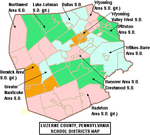Forty Fort

Forty Fort was a stronghold built by settlers from Connecticut, on the Susquehanna River in what is now Luzerne County, Pennsylvania. Before the American Revolutionary War, both Connecticut and Pennsylvania claimed this territory, as Connecticut had laid claim to a wide swath of land to its west based on its colonial charter. These competing claims triggered the Pennamite-Yankee Wars but were resolved after the Revolutionary War when the federal government awarded the contested territory to Pennsylvania.The fort was a refuge for settlers during the Battle of Wyoming on July 3, 1778. Lieutenant Colonel Zebulon Butler's force of largely militia soldiers was defeated by a force of Loyalist soldiers from Butler's Rangers and their indigenous allies. Forty Fort capitulated the following day. The fort was reoccupied by the Americans later that year.
Excerpt from the Wikipedia article Forty Fort (License: CC BY-SA 3.0, Authors, Images).Forty Fort
River Street,
Geographical coordinates (GPS) Address Nearby Places Show on map
Geographical coordinates (GPS)
| Latitude | Longitude |
|---|---|
| N 41.28528 ° | E -75.87304 ° |
Address
River Street
River Street
18704
Pennsylvania, United States
Open on Google Maps








